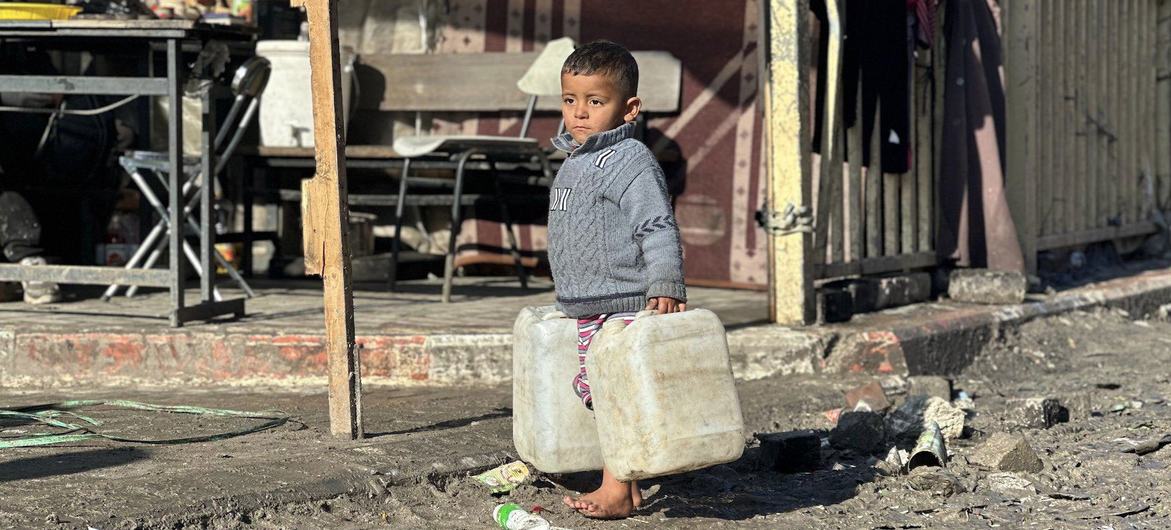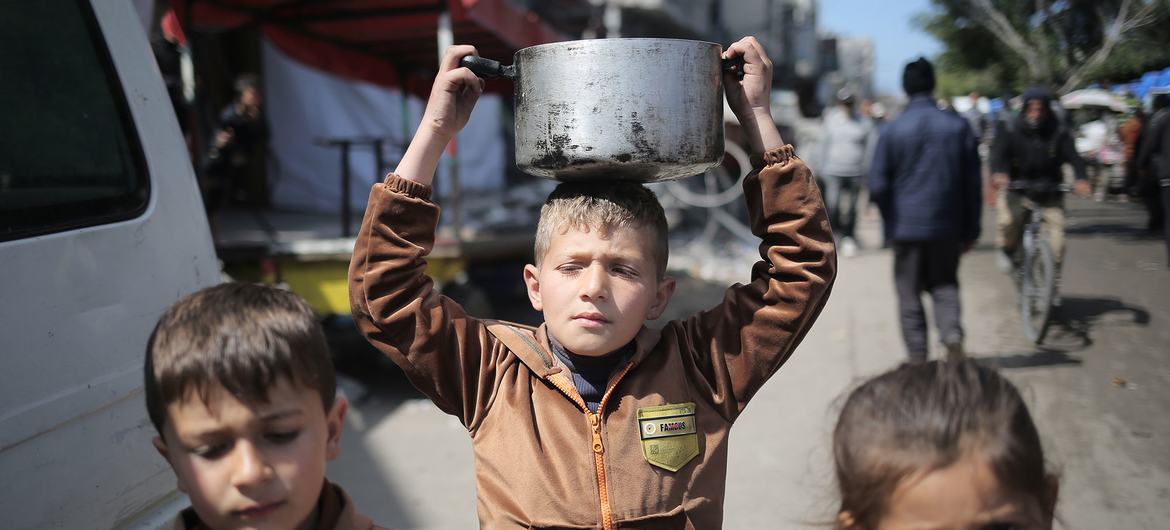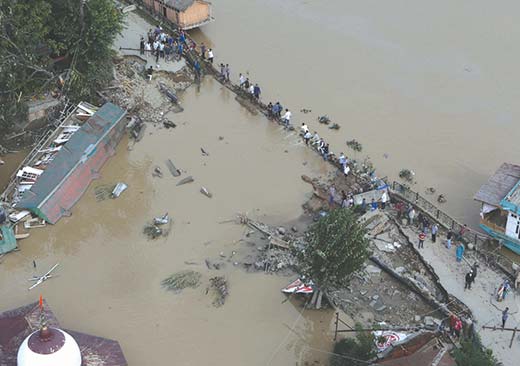UN News: UN-coordinated food convoys are three times more likely to be denied access to north Gaza than other aid convoys, the UN Humanitarian Affairs Office, United Nations Office for Coordination of Humanitarian Affairs (OCHA), reported on Tuesday.

Israeli authorities have not given a clear reason why, said OCHA Spokesperson Jens Laerke, speaking during the regular briefing by UN humanitarian agencies in Geneva.
“They very often deny and that is it, and it ends there. We do not get an explanation,” he said.
In a widely reported telephone call last Thursday between United States President Joe Biden and Israeli Prime Minister Benjamin Netanyahu, Israel committed to reopen the Erez border crossing into northern Gaza as well as facilitate aid delivery via the nearby port of Ashdod.
The White House said it would be watching closely but no date has been set by Israel to act and the concession over expanding routes into Gaza has yet to materialize, according to news reports.
Laerke was asked about the opening of more aid corridors, particularly the Erez crossing, but said as of Monday night, OCHA had not received any information that it had opened.
Denials and impediments
OCHA issued a report this week which said that restrictions and denials of planned aid movements by Israeli authorities continue to hamper the delivery of life-saving assistance to the shattered enclave.
During March, more than half of UN-coordinated food missions to high-risk areas requiring coordination with Israeli authorities were either denied or impeded.
Laerke was responding to journalists’ questions about the number of aid trucks entering Gaza and discrepancies between Israeli and UN figures.
The Israeli defence ministry unit that coordinates and facilitates humanitarian aid for Gaza, known as COGAT, counts trucks that it screens and sends across the border while OCHA counts trucks that arrive at its warehouses, and “between those two, there are issues.”

Comparison ‘makes little sense’
Trucks screened by COGAT are typically only half full, in line with its requirements, he said.
“When we count the trucks on the other side when they have been reloaded…they are full. Already there, the numbers will never match up,” he continued.
He explained that counting day to day and comparing numbers “makes little sense” as it does not take into account delays at the crossing and in moving to warehouses.
Israeli-imposed restrictions also prohibit Egyptian drivers and trucks from being in the same area at the same time as Palestinian drivers and trucks, so handovers are not smooth.
Access to north Gaza
Laerke stressed that moving aid inside Gaza “is another complication”, referring to the impediments and access denials.
“Food convoys that should be going particularly to the north, where 70 per cent of people face famine conditions, are more likely, actually three times more likely, to be denied than any other humanitarian convoy with other kinds of material,” he said.
He told journalists that aid distribution inside Gaza “is a major issue” due to security and safety reasons, and the breakdown of law and order.
“But we also stress that the obligation on the warring parties – and, in particular, I would say on Israel as the occupying power of Gaza – to facilitate and ensure humanitarian access does not stop at the border,” he said.
OCHA Report
The population in the Gaza Strip continues to face an unprecedented humanitarian crisis, characterised by intense hostilities and escalating humanitarian access constraints that have severely impeded the delivery of life-saving humanitarian assistance and services. While humanitarian organisations continue efforts to scale up response operations, intense aerial bombardment in densely populated urban areas, large-scale military ground operations, unexploded ordnance (UXO) contamination, prevailing insecurity, the closure of key border crossings, movement restrictions, infrastructure damage and persistent access restrictions and denials by Israeli authorities have generated a volatile, insecure, and non-permissive operational environment. These obstacles are hindering the ability of humanitarian actors to address the essential needs of Gaza’s population.
Famine is imminent in Gaza as 1.1 million people—half of Gaza’s population—are facing conditions of catastrophic food insecurity due to the intense conflict and severe limitations on humanitarian access. Urgent action is required from Israeli authorities and all parties to the conflict to facilitate safe, unimpeded access for humanitarian organizations to respond to the urgent needs of Gaza’s population.
Humanitarian Notification System (HNS)
The Humanitarian Notification System is designed to inform all parties to the conflict about the location of humanitarian compounds and the movements of humanitarian entities to avoid collateral harm or damages and enhance the safety and security of humanitarian sites, operations, and personnel.
In Gaza, depending on the level of assessed risk, there are – at present – two different types of humanitarian movement procedures: Notification: movements to areas considered less sensitive and Coordination: movements to areas with increased risks.
Humanitarian notification does not change the IHL obligations of the parties to the conflict but rather supports their ability to meet those obligations by better informing them of humanitarian presence. Furthermore, the provision of location information by humanitarian partners using the HNS is strictly voluntary.
Persistent Access Restrictions
In March, an array of access restrictions and denials imposed by Israeli authorities continue to obstruct and limit humanitarian operations throughout Gaza. Israeli authorities have authorised the use of only one primary border crossing preventing humanitarian assistance or commercial goods from entering directly into northern Gaza, where levels of catastrophic food insecurity and humanitarian needs are most acute. In addition, lengthy inspection processes, fuel shortages resulting from Israeli restrictions, and restrictions on the movement of trucks, convoys, and vetted drivers create significant delays, while congestion at the Kerem Shalom crossing present a major operational bottleneck.
Moreover, the Israeli authorities’ designation of the Al Rasheed Coastal Road as the primary route for humanitarian movement between Gaza’s southern and northern areas has caused significant delays. The majority of humanitarian convoys travelling northward must navigate high-security risk areas and a single Israeli checkpoint on the Salah Ad Din Road, leading to increased road congestion, substantial delays and exacerbated logistical constraints. Access to medical facilities was particularly constrained. In the last week of March, all four planned medical missions to Al Shifa Hospital were either denied or impeded.
Israeli authorities continue to impose constraints limiting humanitarian actors’ use of the central Salah Al Deen Road, which could potentially offer a more efficient and potentially more secure option, enhancing the efficiency and effectiveness of aid distributions. Humanitarian agencies continue to seek authorisations for alternative crossings in the north and routes, such as the Fence Road on Gaza’s western border where only five convoys were facilitated out of the 16 coordinated missions planned (three of these were postponed by the organization due to operational constraints).
Prevailing movement restrictions and shortage of approved trucks and drivers continue to result in considerable delays, particularly limiting the quantity and frequency of humanitarian food convoys and distributions. In addition, in late March, Israeli authorities announced that one of the three partners delivering food in Gaza would no longer be allowed in northern Gaza, where more than 300,000 people face catastrophic food security conditions. Amid imminent famine and severe levels of acute food insecurity, food distributions in Gaza continue to encounter persistent challenges in mission coordination and encounter a high proportion of mission denials, postponements, or impediments.
In March, in areas requiring coordination with IDF, only 26 per cent of requested humanitarian food missions were facilitated by Israeli authorities. The remaining convoys were denied by Israeli authorities (40 per cent), postponed (20 per cent), impeded (11 per cent), or withdrawn (3 per cent) due to prevailing restrictions, security concerns, or operational constraints.
Intense Hostilities and Widespread Insecurity Severely Impede Humanitarian Operations, Endanger Civilians and Aid Workers
Intense hostilities in Gaza and widespread insecurity continue to undermine humanitarian access by threatening the safety of humanitarian personnel delivering assistance and restricting the ability of civilians to access essential services. Insecurity throughout Gaza has been further exacerbated by attacks directly affecting humanitarian and medical facilities.
More than 190 aid workers have been killed in Gaza between 7 October 2023 and 31 March 2024, including at least seven aid workers during March. This total includes the highest number of UN personnel killed in a conflict in the history of the organization. In addition, Israeli military operations and airstrikes have repeatedly affected medical facilities throughout Gaza and humanitarian facilities — including an aerial strike on a humanitarian food distribution centre on 13 March in Rafah — resulting in casualties of medical staff, humanitarian personnel, and civilians, despite ongoing humanitarian notification and coordination mechanisms with Israeli authorities.
Months of intense armed conflict have also resulted in a general breakdown of law and order within Gaza, generating additional security and protection risks for civilians and humanitarian organizations. In March, heightened violence affecting humanitarian convoys caused disruptions in aid distributions, as crowds in dire need of essential supplies sought resources for their survival. While previous disruptions were mainly centred around the Wadi Gaza Israeli checkpoint in northern Gaza, new issues arose in southern Gaza during March, including increased incidents of theft, disorganized gathering points, and violence affecting humanitarian personnel and assets.
While humanitarian actors are attempting to introduce temporary and alternative aid entry routes into Gaza, including airdrops and maritime transport routes, these cannot replace the utilization of land crossings and routes within Gaza, which are essential for implementing humanitarian operations at scale.
Physical Access Constraints
Heavy damage and destruction of roads caused by ongoing hostilities in Gaza continue to present physical access barriers and restrict humanitarian movements within Gaza. The remaining operational routes are often impassable and heavily congested due to significant infrastructural damage, heavy debris, and UXO contamination. As a result, the ability of humanitarian organizations to effectively deliver life-saving assistance to those in need remains compromised. Efforts to repair damaged roads and secure safe passage for humanitarian convoys are essential to addressing these challenges and ensuring that aid reaches those who need it most.















